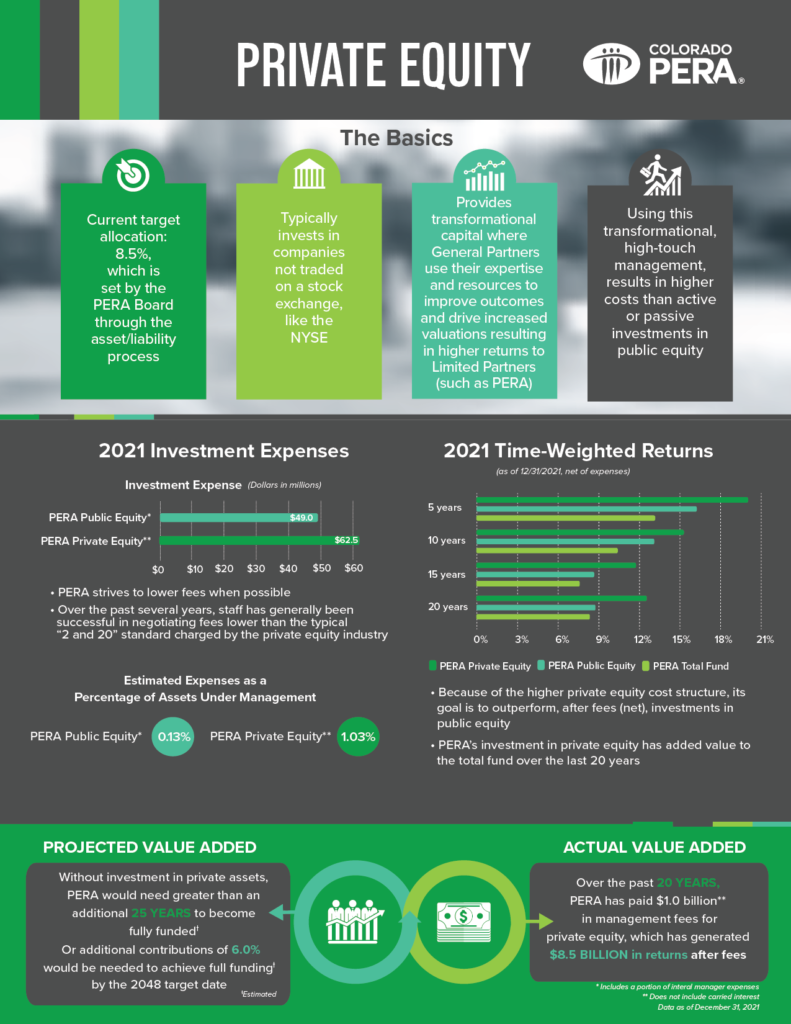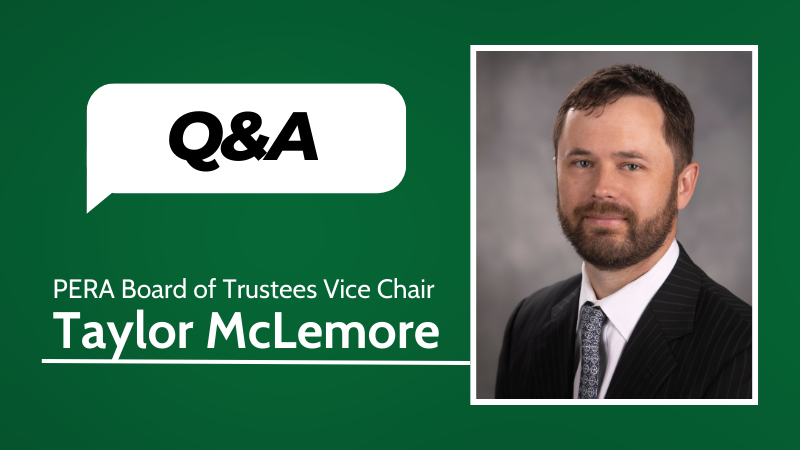Note: This article is part of a series highlighting each of PERA’s investment asset classes and how they contribute to a diversified portfolio that provides reliable income to Colorado’s retired public employees.
Global Equity, Fixed Income, and Real Estate make up the bulk of PERA’s investment portfolio, but some of the plan’s smaller investments can be the strongest performers.
PERA’s fourth-biggest asset class is Private Equity, which made up approximately 10% of the total fund as of Sept. 30, 2022. Private Equity is an important part of the portfolio because of its potential for larger returns compared to other asset classes .
What is Private Equity?
Whereas Public Equity consists of shares in companies that are traded on public stock exchanges, Private Equity involves companies that are not publicly traded. Some common Private Equity activities include:
- Buyouts: Purchasing a company or a portion of a company with the aim of increasing its value and then selling at a profit.
- Venture capital: Providing funding to a new business in exchange for a share in the company, with the potential of making money if the business is successful.
- Growth capital: Providing funding to a mature business that needs money to expand.
Tim Moore, PERA’s Director of Private Equity, said PERA invests in Private Equity through limited partnerships or funds, rather than making those transactions directly.
“We are looking to partner with Private Equity and venture capital firms (general partners or sponsors) with whom we give varying degrees of discretion to invest on our behalf,” Moore said. “These sponsors typically have expertise in specific areas or industries like consumer products, technology, energy, healthcare and other broad sectors.”
PERA was an early investor in Private Equity, making its first investment in 1982. Since then, the Private Equity team has been able to develop relationships with many of the key investors and top-performing funds in the asset class
“The Private Equity team has a long tenure here at PERA, averaging more than fifteen years with the organization,” Moore said.
Why invest in Private Equity?
The costs of participating in Private Equity are higher than for publicly traded assets, but the expectations for performance in the asset class are also higher. Over time, Private Equity has outperformed the public markets and delivered higher returns to the PERA fund. That means more money in the trust funds that provide benefits to Colorado’s public employees.
Over the past 20 years, Private Equity has generated approximately $8.5 billion dollars after fees, which provides an important boost to PERA’s finances. Without that income, it would take an estimated 25-plus additional years or extra contributions from public workers and their employers for PERA to reach its funding goal.
Promoting transparency
Unlike Global Equity and Fixed Income, where the price of the investment is publicly known, much of the information on the underlying investments in Private Equity isn’t public. In fact, Colorado state law limits how much information PERA can disclose about its Private Equity investments.
Within the limits of the law, PERA posts a summary of its Private Equity investments online each year after they are audited, and staff provide more detailed information to the Board of Trustees. PERA was also an early supporter of the Institutional Limited Partner Association (ILPA), an organization that aims to improve reporting and transparency within the Private Equity field.
Click here for more information on PERA’s Private Equity holdings.
Like the other asset classes, the Private Equity team maintains a focus on achieving returns over the long term rather than seeking out short-term gains. The result is strong performance that helps ensure the sustainability of the fund.
“Private Equity is a small portion of PERA’s overall portfolio, but it’s an important one,” Moore said. “By seeking out investment opportunities that outperform compared to other asset classes, we can ensure PERA has sufficient cash flow to provide reliable benefits to all our members and retirees who rely on them.”
More information about PERA’s investments:
- Colorado PERA Investment stewardship Report
- Statement of Investment Policy
- PERA Asset Allocation
- PERA asset classes
- PERA Investment FAQs
Global equityA type of investment that includes publicly traded stocks in companies based in the United States and abroad.Asset classesA category of similar investments. Common asset classes include global equity (such as publicly traded stocks), real estate, and cash.Trust fundA fund in which money and/or other assets are held and managed by trustees on behalf of plan participants. PERA maintains trust funds for each of its Defined Benefit Plan divisions (State, Local Government, School, Denver Public Schools, and Judicial).StewardshipThe practice of overseeing or managing something entrusted to one’s care. PERA’s approach to investment stewardship is focused on ensuring the financial sustainability of the fund that pays benefits to retirees and beneficiaries.StewardshipThe practice of overseeing or managing something entrusted to one’s care. PERA’s approach to investment stewardship is focused on ensuring the financial sustainability of the fund that pays benefits to retirees and beneficiaries.Asset allocationAn investor’s mix of stocks, bonds, and other investments. PERA’s strategic asset allocation is set by the PERA Board of Trustees.Public equityA type of investment in which investors purchase shares of a company that is traded on a public stock exchange.Private equityA type of investment in which investors purchase shares of a company that is not traded on a public stock exchange.Private equityA type of investment in which investors purchase shares of a company that is not traded on a public stock exchange.Fixed incomeA type of investment that pays investors a fixed rate of interest over a set period of time. Bonds are a common type of fixed income investment.Asset classA category of similar investments. Common asset classes include global equity (such as publicly traded stocks), real estate, and cash.Asset classA category of similar investments. Common asset classes include global equity (such as publicly traded stocks), real estate, and cash.Asset classA category of similar investments. Common asset classes include global equity (such as publicly traded stocks), real estate, and cash.





